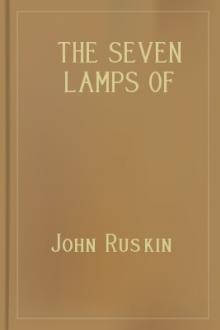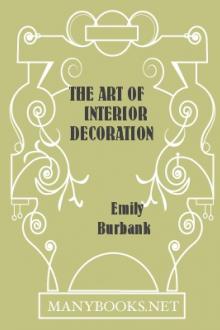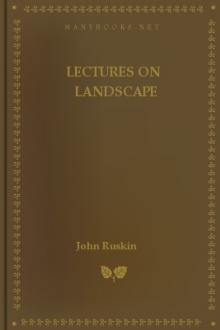The Seven Lamps of Architecture by John Ruskin (books like harry potter TXT) 📕

- Author: John Ruskin
- Performer: -
Book online «The Seven Lamps of Architecture by John Ruskin (books like harry potter TXT) 📕». Author John Ruskin
The leaf of this plant has five ribs on each side, as its flower generally five masts, arranged with the most exquisite grace of curve; but of lateral proportion I shall rather take illustrations from architecture: the reader will find several in the accounts of the Duomo at Pisa and St. Mark's at Venice, in Chap. V. §§ XIV.-XVI. I give these arrangements merely as illustrations, not as precedents: all beautiful proportions are unique, they are not general formulæ.
XXX. The other condition of architectural treatment which we proposed to notice was the abstraction of imitated form. But there is a peculiar difficulty in touching within these narrow limits on such a subject as this, because the abstraction of which we find examples in existing art, is partly involuntary; and it is a matter of much nicety to determine where it begins to be purposed. In the progress of national as well as of individual mind, the first attempts at imitation are always abstract and incomplete. Greater completion marks the progress of art, absolute completion usually its decline; whence absolute completion of imitative form is often supposed to be in itself wrong. But it is not wrong always, only dangerous. Let us endeavor briefly to ascertain wherein its danger consists, and wherein its dignity.
XXXI. I have said that all art is abstract in its beginnings; that is to say, it expresses only a small number of the qualities of the thing represented. Curved and complex lines are represented by straight and simple ones; interior markings of forms are few, and much is symbolical and conventional. There is a resemblance between the work of a great nation, in this phase, and the work of childhood and ignorance, which, in the mind of a careless observer, might attach something like ridicule to it. The form of a tree on the Ninevite sculptures is much like that which, come twenty years ago, was familiar upon samplers; and the types of the face and figure in early Italian art are susceptible of easy caricature. On the signs which separate the infancy of magnificent manhood from every other, I do not pause to insist (they consist entirely in the choice of the symbol and of the features abstracted); but I pass to the next stage of art, a condition of strength in which the abstraction which was begun in incapability is continued in free will. This is the case, however, in pure sculpture and painting, as well as in architecture; and we have nothing to do but with that greater severity of manner which fits either to be associated with the more realist art. I believe it properly consists only in a due expression of their subordination, an expression varying according to their place and office. The question is first to be clearly determined whether the architecture is a frame for the sculpture, or the sculpture an ornament of the architecture. If the latter, then the first office of that sculpture is not to represent the things it imitates, but to gather out of them those arrangements of form which shall be pleasing to the eye in their intended places. So soon as agreeable lines and points of shade have been added to the mouldings which were meagre, or to the lights which were unrelieved, the architectural work of the imitation is accomplished; and how far it shall be wrought towards completeness or not, will depend upon its place, and upon other various circumstances. If, in its particular use or position, it is symmetrically arranged, there is, of course, an instant indication of architectural subjection. But symmetry is not abstraction. Leaves may be carved in the most regular order, and yet be meanly imitative; or, on the other hand, they may be thrown wild and loose, and yet be highly architectural in their separate treatment. Nothing can be less symmetrical than the group of leaves which join the two columns in Plate XIII.; yet, since nothing of the leaf character is given but what is necessary for the bare suggestion of its image and the attainment of the lines desired, their treatment is highly abstract. It shows that the workman only wanted so much of the leaf as he supposed good for his architecture, and would allow no more; and how much is to be supposed good, depends, as I have said, much more on place and circumstance than on general laws. I know that this is not usually thought, and that many good architects would insist on abstraction in all cases: the question is so wide and so difficult that I express my opinion upon it most diffidently; but my own feeling is, that a purely abstract manner, like that of our earliest English work, does not afford room for the perfection of beautiful form, and that its severity is wearisome after the eye has been long accustomed to it. I have not done justice to the Salisbury dog-tooth moulding, of which the effect is sketched in fig. 5, Plate X., but I have done more justice to it nevertheless than to the beautiful French one above it; and I do not think that any candid reader would deny that, piquant and spirited as is that from Salisbury, the Rouen moulding is, in every respect, nobler. It will be observed that its symmetry is more complicated, the leafage being divided into double groups of two lobes each, each lobe of different structure. With exquisite feeling, one of these double groups is alternately omitted on the other side of the moulding (not seen in the Plate, but occupying the cavetto of the section), thus giving a playful lightness to the whole; and if the reader will allow for a beauty in the flow of the curved outlines (especially on the angle), of which he cannot in the least judge from my rude drawing, he will not, I think, expect easily to find a nobler instance of decoration adapted to the severest mouldings.
Now it will be observed, that there is in its treatment a high degree of abstraction, though not so conventional as that of Salisbury: that is to say, the leaves have little more than their flow and outline represented; they are hardly undercut, but their edges are connected by a gentle and most studied curve with the stone behind; they have no serrations, no veinings, no rib or stalk on the angle, only an incision gracefully made towards their extremities, indicative of the central rib and depression. The whole style of the abstraction shows that the architect could, if he had chosen, have carried the imitation much farther, but stayed at this point of his own free will; and what he has done is also so perfect in its kind, that I feel disposed to accept his authority without question, so far as I can gather it from his works, on the whole subject of abstraction.
XXXII. Happily his opinion is frankly expressed. This moulding is on the lateral buttress, and on a level with the top of the north gate; it cannot therefore be closely seen except from the wooden stairs of the belfry; it is not intended to be so seen, but calculated for a distance of, at least, forty to fifty feet from the eye. In the vault of the gate itself, half as near again, there are three rows of mouldings, as I think, by the same designer, at all events part of the same plan. One of them is given in Plate I. fig. 2 a. It will be seen that the abstraction is here infinitely less; the ivy leaves have stalks and associated fruit, and a rib for each lobe, and are so far undercut as to detach their forms from the stone; while in the vine-leaf moulding above, of the same period, from the south gate, serration appears added to other purely imitative characters. Finally, in the animals which form the ornaments of the portion of the gate which is close to the eye, abstraction nearly vanishes into perfect sculpture.
XXXIII. Nearness to the eye, however, is not the only circumstance which influences architectural abstraction. These very animals are not merely better cut because close to the eye; they are put close to the eye that they may, without indiscretion, be better cut, on the noble principle, first I think, clearly enunciated by Mr. Eastlake, that the closest imitation shall be of the noblest object. Farther, since the wildness and manner of growth of vegetation render a bona fide imitation of it impossible in sculpture—since its members must be reduced in number, ordered in direction, and cut away from their roots, even under the most earnestly imitative treatment,—it becomes a point, as I think, of good judgment, to proportion the completeness of execution of parts to the formality of the whole; and since five or six leaves must stand for a tree, to let also five or six touches stand for a leaf. But since the animal generally admits of perfect outline—since its form is detached, and may be fully represented, its sculpture may be more complete and faithful in all its parts. And this principle will be actually found. I believe, to guide the old workmen. If the animal form be in a gargoyle, incomplete, and coining out of a block of stone, or if a head only, as for a boss or other such partial use, its sculpture will be highly abstract. But if it be an entire animal, as a lizard, or a bird, or a squirrel, peeping among leafage, its sculpture will be much farther carried, and I think, if small, near the eye, and worked in a fine material, may rightly be carried to the utmost possible completion. Surely we cannot wish a less finish bestowed on those which animate the mouldings of the south door of the cathedral of Florence; nor desire that the birds in the capitals of the Doge's palace should be stripped of a single plume.
XXXIV. Under these limitations, then, I think that perfect sculpture may be made a part of the severest architecture; but this perfection was said in the outset to be dangerous. It is so in the highest degree; for the moment the architect allows himself to dwell on the imitated portions, there is a chance of his losing sight of the duty of his ornament, of its business as a part of the composition, and sacrificing its points of shade and effect to the delight of delicate carving. And then he is lost. His architecture has become a mere framework for the setting of delicate sculpture, which had better be all taken down and put into cabinets. It is well, therefore, that the young architect should be taught to think of imitative ornament as of the extreme of grace





Comments (0)